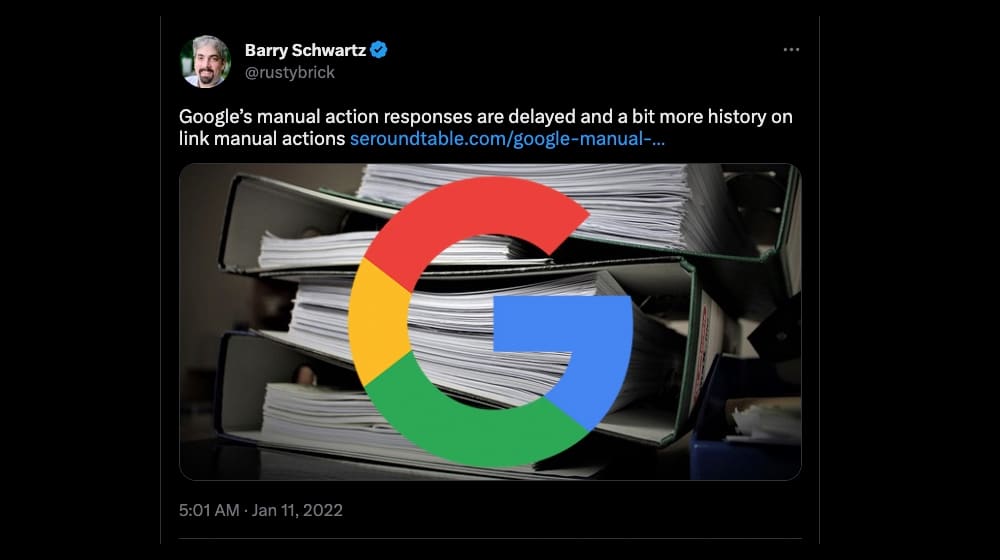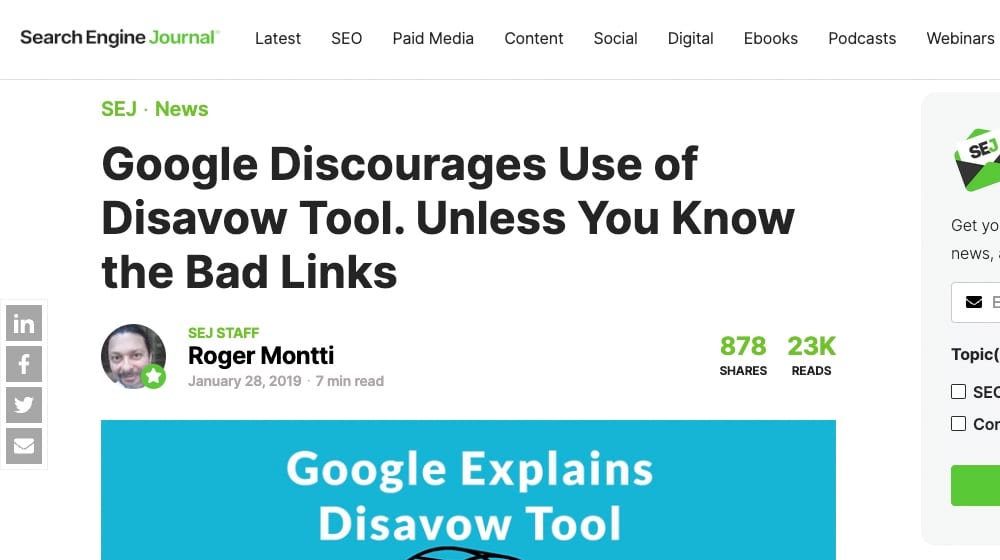Why Did My Traffic Drop After Submitting a Disavow File?

Backlinks are one of the essential parts of SEO, but like any powerful tool, marketers can use them for good and evil. Good links that are relevant, helpful, organic, and from reputable websites can improve your organic search performance.
Toxic backlinks do nothing for you at best. At worst, these links can hurt your site.
When Google analyzes your backlink profile and believes you've been buying fake links, participating in a private blog network, or otherwise trying to game the system, its algorithm will respond appropriately by discounting those spammy links or reducing visibility in the search results.
You don't control other sites on the web, nor can you control your inbound links, so if bad sites links to you and if you believe it's hurting your SEO, what can you do about it? After all, asking the webmaster nicely to remove them isn't a foolproof plan.
The answer is using Google's Disavow Tool. The trouble is, this can backfire just as much as your link-building efforts can.
The Google disavow tool has been around for over a decade and was launched shortly after the Google Penguin algorithm update (which targeted spam links) was rolled out in 2012.
You build a list of toxic sites and pages linking to you that you believe shouldn't be, and you submit that list to Google. Google processes it, decides whether or not they think you should have that link removed from the calculations for your ranking, and calculates a new position based on your link profile (minus those low-quality links).

It seems like a winning option. All you need to do is identify the backlinks that hurt your site and disavow them, and you get a free traffic boost. Right?
It's understandably concerning when you submit a disavow file and see an immediate drop in ranking and traffic. This situation is pretty common, though, and it helps to understand why it's happening.
So, what's going on? There are a handful of potential causes.
Reason #1: The Links Weren't Actually Bad
The first option, and usually the most common cause of dropping traffic, is that the links you chose to disavow weren't actually hurting your site.
Now, sure, some of these bad backlinks might be dangerous to keep around. If you know that they're a little spammy or come from private blog networks and could cause a problem, disavowing them could be a good proactive measure to prevent a penalty later.
On the other hand, if the links provide you with value when you disavow them, your traffic and rankings will drop because of it. It's just like any other high-quality link; removing it will hurt your site.
There are a lot of reasons why site owners get this wrong:
- One of the biggest is relying on third-party analytics to pick the links for your to disavow. Various link analysis platforms, like Moz, Ahrefs, Semrush, or Majestic, will rate your backlinks and give you an idea of their quality. The trouble is the rating these sites use, and the rating Google uses will always be different because no one knows what Google thinks about your links except for Google.
- It's also possible that a link you think looks sketchy is perfectly fine. I see this a lot when people analyze their backlinks and show me a list that includes, for example, links from foreign language sites. They can't read those sites, assume the reverse is accurate, and decide to disavow them. In reality, they're perfectly acceptable links. They might not help your English rankings much, but they give you traffic from those sources and give Google some extra context.
- Overusing the disavow tool and sniping links that were either neutral or beneficial to your site is the most common cause of a traffic drop after submitting a disavow file. However, you can tell if this is or isn't caused by the timing. Specifically, if the timing of the traffic drop comes a month or so after you submit the file – and there's no corresponding Google update – this is likely to be the cause.
You can test it by removing the links from your disavow file (or removing the file entirely) and waiting a few months to see if your traffic returns. If it does, you have your answer.
According to John Mueller, it can take a few months for Google to process your disavow file, making it challenging to align the timing of the disavow with your organic search performance:
Removing the disavow file follows a similar process; you shouldn't expect these changes to happen overnight. When in doubt, I recommend giving it a few months before assessing the situation. Seeing a temporary drop in traffic after submitting a disavow request isn't unusual. More on that in a minute.
Reason #2: Google Variance in Processing
Do you know about the Google "sandbox"?
No, I don't mean their career internship system; I mean the nickname marketers have given their quarantine system for new sites.
There's a similar effect that happens when you submit a disavow file. Google takes time to process the file. They have to look into each link, determine if they want to accept your disavowal (remember, they reserve the right to ignore your request and keep the link in effect), and re-analyze your site in context to determine if your site's rankings have improved.
A disavow file with hundreds or thousands of spammy links can take a long time.
Google is months behind on reviewing penalties and manual actions, for example, so it takes quite a while to process and re-analyze your rankings.

So, you might experience a drop in traffic, a rise in traffic, and a lot of variances while they go through your file and figure out what they want to do for each link.
Reason #3: Coincidental Google Algorithm Updates
How often does Google's algorithm update?
This one is a tricky question to answer. Moz maintains a list of observed and announced updates and algorithm changes. They show somewhere between 1-3 updates per month, with some variance depending on whether or not Google is rolling out something big or just doing maintenance updates.
Google recently rolled out its own list of all confirmed search engine updates as well.

Realistically, though, Google is constantly making micro-adjustments that affect statistically insignificant numbers of sites, which can affect your site quite a bit.
It's entirely possible that some change to the algorithms hit your site and reduced your traffic shortly after you submitted your disavow file, and you don't know about it, either because Google didn't announce the update or because it affects too few sites to even really be recorded above the background variance of constantly-shifting SEO values.
The key indicator here is speed. If you submit your disavow file and you see a drop in traffic within a week or two, chances are that traffic drop has nothing to do with your disavowed links.
It's simply too fast to be responsible, so it's more likely to be a coincidence.
Other Reasons Your Site Might Be Dropping
There are plenty of other reasons your traffic might drop gradually or suddenly.
Why not check the list and see if these have applied to your site in the past few days, weeks, or months?
- You set noindex or nofollow somewhere on your site in a way that hurts your indexation or internal linking.
- You've been publishing low-quality content, and it's finally catching up to you; alternatively, Google has pushed their standards for quality content up a bit higher, and you no longer meet them.
- You have a critical mass of broken or unnatural links on your site pointing to bad, missing, or spammy pages, and you still need to clean them up.
- Your use of keywords has gotten to be too much, and you're stepping into the realms of over-optimization and keyword stuffing, particularly if you've started using tools to assist you in adding keywords in content where you wouldn't usually use them.
- The keywords you're using to rank are dropping out of favor, either because trends are fading, names are changing, or the topics are aging out of relevance.
- Your website is slow or has gotten slower, and you haven't done anything to speed it up. Remember, page speed is a core ranking factor, especially on mobile.
- Speaking of mobile, your mobile web experience is poor. Google shifted to mobile-first indexing a few years ago, so if your mobile site is pretty bad, that's going to reflect poorly on you.
- You've lost some good backlinks recently. This drop can have nothing to do with the disavow tool. Sites revamp themselves, audit their content, remove old content, change out links, or even die off all the time, even if they're functioning fine on the front end. If you get traffic or value from links from a site that disappears or removes the content linking to you, you'll likely see a drop.
- Something you did resulted in a Google penalty. Actual Google penalties, called Manual Actions, can be found in Google Search Console. You can check for penalties, and if you have any, Google will tell you exactly what they are and why you have them. You can do a full audit to diagnose issues as well.
- You have competitors that are investing in new content and link building in a way that poaches some of your organic traffic and value. Maybe they created content to out-rank your ranking content, perhaps they poached some links, or maybe they're paying for ads on your keywords; whatever the case is, you haven't made any changes lately, but the competition has surged.
- You've been slacking on the technical aspects of SEO. Things like page metadata, image alt text, and other minor elements of SEO are easy to ignore or let slip when you're focusing on bigger issues. But eventually, they'll catch up to you, and you'll end up with a huge pile of tedious busywork to do just to get back to where you should have been.
- Seasonal shifts in traffic you forgot about. Seeing a declining chunk of time in analytics can be disheartening, but from a full-year perspective, you might know that it's just a temporary slump you go through every year. There are seasonal surges and drifts in traffic throughout the year, and it's possible you're in one of your slow periods and didn't consider that it was happening.
- Changes you made to your site, particularly to your site structure or navigation, can require a whole new re-processing before Google figures out what you've done. Redirects can help, especially if you've made major changes to your URL structure, but it can still take weeks or months for you to return to your former rankings.
The disavow tool can be responsible for a drop in organic traffic, but there are a lot of other reasons why they might happen that are both more likely and more common, so you may want to check them first.
Should You Bother Using the Disavow Tool?
Google has invested a lot of resources into its algorithm, particularly in training it how to adapt to various factors that can impact a site. They can analyze links on the fly and assign them appropriate values or no value at all.
The truth is, the disavow tool was primarily meant for cases where sites had a lot of legacy bad links they wanted to get rid of and for fighting back against negative SEO.
Over time (and again, it's been over ten years since the disavow tool was released), Google has gotten infinitely better at adapting to unnatural links on the fly. Toxic links can be devalued automatically, negative SEO can be detected and rendered null, and most spam links are simply counted as zero value rather than negative value. They've even started to discourage people from using it. There's pretty much no reason to keep using the disavow tool at this point.

There are still the occasional good reasons why you could use the disavow tool, but 99% of the time, it's not worth the risk or the hassle. Getting a few new good backlinks will likely be more beneficial than disavowing a few bad links across the board.










Comments